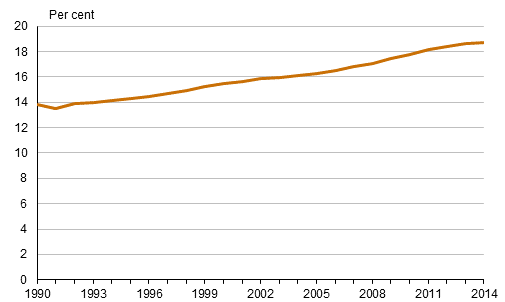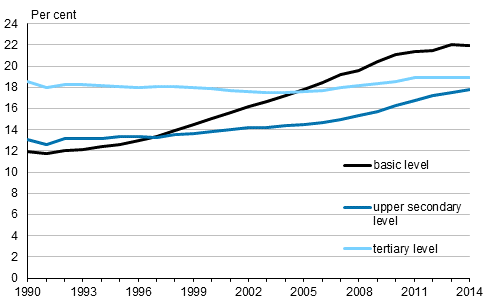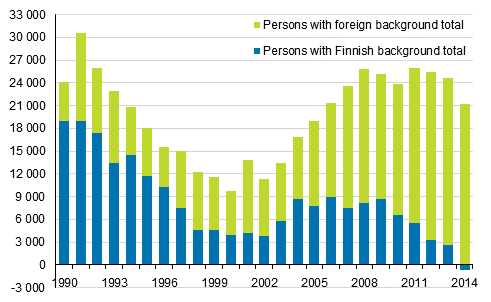Published: 10 December 2015
Nearly every fifth woman aged 45 to 49 has not given birth
According to Statistics Finland's statistics on the population structure, 18.7 per cent of women aged 45 to 49 resident in Finland and speaking national languages as their mother tongue have not given birth to a child. In 1990, the corresponding percentage was 13.8. The share of women who have given birth has been falling slowly but constantly.
Share of women aged 45 to 49 not having given birth among women speaking national languages in 1990 to 2014

Share of women not having given birth growing particularly among those with a lower level of education
When the development of the share of women not having given birth is examined by education, the trends in development are different in various levels of education. In 2014, the share of women not having given birth among women aged 45 to 49 speaking national languages as their mother tongue and with only basic level qualifications was 22.0 per cent. In 1990, the respective share was only 12.0 per cent.
In 2014, the share of women not having given birth among women aged 45 to 49 with upper secondary level qualifications was 17.8 per cent, while in 1990 their respective share was 13.0 per cent.
Among highly educated women, the share of women having given birth has not in practice fallen. In 1990, women not having given birth had a share of 18.6 per cent among women aged 45 to 49 with tertiary level degrees. The corresponding share was 18.9 per cent in 2014.
Share of women aged 45 to 49 not having given birth among women speaking national languages in 1990 to 2014

Share of women not having given birth has fallen among upper-level salaried employees, risen among workers
Distinct differences can also be seen when we examine employed women aged 45 to 49 speaking national languages as their mother tongue by socio-economic group. Among upper-level salaried employees, the share of women not having given birth has even gone down. In 1995, the share of women not having given birth among women aged 45 to 49 belonging to upper-level salaried employees was 19.5 per cent. The corresponding share was 17.7 per cent in 2013.
In contrast, the share of women not having given birth among women aged 45 to 49 belonging to lower-level salaried employees was 13.3 per cent in 1995 and 15.6 per cent in 2013.
In 1995, the share of women not having given birth among women aged 45 to 49 belonging to employed workers was 10.6 per cent in 1995. In 2013, the corresponding percentage was 18.2.
Share of women not having given birth has risen drastically among unemployed women aged 45 to 49
The differences are even bigger when viewed by main type of activity. Among women aged 45 to 49 speaking national languages as mother tongue, the share of women not having given birth was around 13 per cent for both unemployed and employed women in 1995. The respective shares in 2013 were 16.4 per cent for those whose main type of activity was employed and 23.5 per cent for unemployed.
Number of persons with Finnish background decreased in 2014
In the course of 2014, Finland’s population grew by 20,483 persons. The number of people with foreign background grew by 21,187 persons, while that of people with Finnish background went down by 704 persons. This is the first time in the examined period 1990 to 2014 when the number of people with Finnish background in the population decreased. However, the decrease is still small: compared to the previous year, 0.01 per cent. In turn, the number of people with foreign background increased by seven per cent.
Change in the population by origin in 1990 to 2014

There were 322,711 persons with foreign background living in Finland in 2014, which was 5.9 per cent of the entire population. There were 273,306 persons of first generation with foreign background, i.e. born abroad, and 49,405 persons of second generation with foreign background, i.e. born in Finland.
Examined by continent, 58 per cent of all persons with foreign background were of European background. The share of persons with Asian background was 24 per cent and that of persons with African background was 12 per cent.
The division of persons with foreign background and persons with Finnish background is related to the classification of origin. See more about the definition of origin here .
New thematic pages on Immigrants and integration opened
More information on the population with immigrant background can be found on Statistics Finland's new thematic pages Immigrants and integration (in Finnish only).
Data related to population structure have already been published on the site and they will be supplemented during December. Results from the Survey on work and well-being among persons of foreign origin are also published on the website.
Source: Population Structure 2014, Statistics Finland
Inquiries: Markus Rapo 029 551 3238, Marja-Liisa Helminen 029 551 3273, vaesto.tilasto@stat.fi
Director in charge: Jari Tarkoma
Publication in pdf-format (390.9 kB)
- Tables
-
Tables in databases
Pick the data you need into tables, view the data as graphs, or download the data for your use.
Appendix tables
- Appendix table 1. Sizes of municipalities by region 31.12.2014 (10.12.2015)
- Appendix table 2. Married women by duration and order of marriage 31.12.2014 (10.12.2015)
- Appendix table 3. Females aged 15 - 79 by number of live-born children 31.12.2014 (10.12.2015)
- Appendix table 4. Males aged 15 - 79 by number of live-born children 31.12.2014 (10.12.2015)
- Appendix table 5. Women by age, number of children and the proportion of birth 31.12.2014 (10.12.2015)
- Appendix table 6. Males by age and number of children 31.12.2014 (10.12.2015)
- Appendix table 7. Population by religious community in 2000 to 2014 (10.12.2015)
- Figures
- Quality descriptions
-
- Quality description: Population structure 2014 (10.12.2015)
Updated 10.12.2015
Official Statistics of Finland (OSF):
Population structure [e-publication].
ISSN=1797-5395. annual review 2014. Helsinki: Statistics Finland [referred: 17.12.2025].
Access method: http://stat.fi/til/vaerak/2014/01/vaerak_2014_01_2015-12-10_tie_001_en.html

